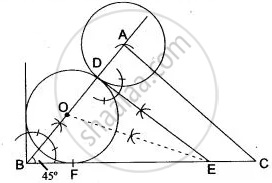Advertisements
Advertisements
प्रश्न
Ruler and compasses only may be used in this question. All constructions lines and arcs must be clearly shown, and the be sufficient length and clarity to permit assessment:
(i) Construct a triangle ABC, in which AB = 9 cm, BC = 10 cm and angle ABC = 45°.
(ii) Draw a circle, with center A and radius 2.5 cm. Let it meet AB at D.
(iii) Construct a circle to touch the circle with center A externally at D and also to touch the line BC.
उत्तर

Steps of construction:
1) Take BC = 10 cm
2) Make ∠ ABC = 45° and with centre B, cut the arc = 9 cm.
3) Join AC, So Δ ABC is the required triangle.
4) With A as centre and radius = 2.5 cm, draw a circle. It will pass through D.
5) Draw DE ⊥ AB, which cuts BC at E.
6) Draw the angle bisector of ∠ BED which cut BD at O.
7) Taking Radius = OD to draw a circle which touches the first circle at D and also touches the line BC at F.
8) This is the required circle. The radius OD = 2.7 cm.
APPEARS IN
संबंधित प्रश्न
Using a ruler and a compass, construct a triangle ABC in which AB = 7 cm, ∠CAB = 60° and AC = 5 cm. Construct the locus of :
- points equidistant from AB and AC.
- points equidistant from BA and BC.
Hence construct a circle touching the three sides of the triangle internally.
Construct a regular hexagon of side 5 cm. Hence construct all its lines of symmetry and name them.
Construct a triangle ABC in which base BC = 6 cm, AB = 5.5 cm and ∠ABC = 120°.
Construct a circle circumscribing the triangle ABC.
Draw a cyclic quadrilateral ABCD so that D is equidistant from B and C.
Using ruler and compasses only,
- Construct triangle ABC, having given BC = 7 cm, AB – AC = 1 cm and ∠ABC = 45°.
- Inscribe a circle in the ΔABC constructed in (i) above. Measure its radius.
Using a ruler and compasses only:
- Construct a triangle ABC with the following data: AB = 3.5 cm, BC = 6 cm and ∠ABC = 120°.
- In the same diagram, draw a circle with BC as diameter. Find a point P on the circumference of the circle which is equidistant from AB and BC.
- Measure ∠BCP.
Using ruler and compasses only, construct Δ ABC in which BC=7.5 cm, ∠ ABC = 60° and AC - AB= 1.5 cm. Inscribe a circle in the Δ ABC and measure its radius.
Perpendicular bisectors of the sides AB and AC of a triangle ABC meet at O.
Does the perpendicular bisector of BC pass through O?
Construct an isosceles triangle ABC such that AB = 6 cm, BC = AC = 4 cm. Bisect ∠C internally and mark a point P on this bisector such that CP = 5 cm. Find the points Q and R which are 5 cm from P and also 5 cm from the line AB.
Use ruler and compasses only for this question:
(i) Construct A ABC, where AB = 3.5 cm, BC = 6 cm and ∠ ABC = 60°.
(ii) Construct the locus of points inside the triangle which are equidistant from BA and BC.
(iii) Construct the locus of points inside the triangle which are equidistant from B and C.
(iv) Mark the point P which is equidistant from AB, BC, and also equidistant from B and C. Measure and record the length of PB.
(i) Construct a triangle ABC, in which AB = 5.0 cm, BC = 3.5 cm and ∠ ABC = `67 1/2°`
( Use a pair of compasses and ruler only.)
(ii) Construct a circle to touch AB at B and it pass though C.
